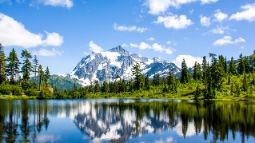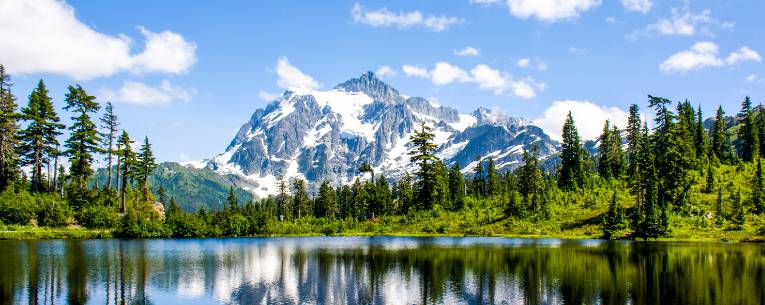“Thousands of tired, nerve-shaken, over-civilized people are beginning to find out that going to the mountains is going home; that wildness is a necessity...”
These words wouldn’t seem out of place in a modern influencer’s social media post (complete with an intermediate-level yoga pose in front of a perfectly-filtered tree, and maybe even a recipe for lentil brownies if you’re lucky). But they’re actually from 1901, written by Scottish-American naturalist John Muir in his book Our National Parks.
Muir was onto something, of course: more than 100 years later, we’re still heading out into nature to escape the stress of everyday life. And with many of us stuck indoors the last few months, the call of the wild is louder than ever—which can mean that popular hiking spots can get more crowded than you’d like these days, especially if you’re trying to keep your social distance.
If you’d like a little more emphasis on distance while still getting a taste of the great outdoors, there are less-populated natural areas that may just do the trick. Here are a few spots across the U.S. that are typically less traveled, and may give you a new view of the world that would make John Muir proud.
(Keep in mind that this is just a short list, and that conditions are subject to change. Many areas are encouraging hikers to stay local, so be sure to obey any state guidelines about where and when you can go. Do your research, check out parks and trails near you, and always go safely. You can find tips on how to recreate responsibly on the National Park Service website.)
No need to adjust your computer settings—the first destination on our list is, indeed, a swamp. And despite its less-than-flattering name, this wild swamp is anything but dismal: in fact, Condé Nast Traveler even recommended it as a “charming slice of rural America.”
This boggy refuge comes recommended for a good reason: it’s home to more than 112,000 acres of rich forested wetlands and diverse wildlife, including otter, deer, butterflies, and the ever-popular vole. While your hike through the park likely won’t be too strenuous—the Tidewater region is notoriously flat—the scenery is green, lush, and mystical. At the center of the swamp you’ll find Lake Drummond, a large freshwater lake with soaring cypress trees that make for an unforgettable view. And if you’re a birdwatcher, you’ll also be able to spot a huge variety of feathered friends during your visit.
The murky habitat has inspired all kinds of folklore over the years, including legends about ghostly inhabitants. The swamp’s actual history is far richer: archeological evidence has begun to confirm that as early as the 1600s, enslaved people used the swamp to escape to freedom, and some even settled there. You’ll find more historical information around the park, so if you’re a hiker and a history buff, the Great Dismal Swamp is the perfect spot to get bogged down.
There’s a reason Alaska is called “The Last Frontier”—the 49th state is home to vast stretches of majestic wilderness, including Wrangell-St. Elias, America’s largest national park. How large is “large,” you ask? At 13.2 million acres, it’s bigger than Switzerland, so you’re likely to find at least a little personal space.
You’ll also find some impressive sites: the park is home to some stunningly large volcanoes, including one currently active volcano called Mount Wrangell (but don’t worry—its last eruption was reported in 1900, and geologists aren’t seeing signs of a repeat just yet). If you’re after chiller views, the park’s mammoth glaciers are bound to fit the bill. The Malaspina Glacier is a can’t-miss—pretty literally, actually, as it’s bigger than the entire state of Rhode Island. You can also get a taste of history with a visit to Kennecott, an abandoned copper mining camp near the center of the park.
The park hosts a wide variety of Alaskan animals, including mountain goats, caribou, wolves, and, if you’re in the coastal area of the park, even sea lions. Check out these tips for viewing some of the park’s wildlife.
Clocking in at over 337,000 acres, Canyonlands is a spectacular place to take a hike if you’re out West. This expansive park is broken up into multiple districts, with breathtaking views of colorful canyons in each. Two of the districts—Island in the Sky and The Needles—both have a variety of hiking options that range from short, scenic jaunts to overnight backpacking trips.
If you head to the The Needles, you can hike Pothole Point, named for the area’s sandstone basins that collect deposits of rainwater (much to the relief of the thirsty desert plants and animals you may see gathering around the area). You can also take a short hike to visit Roadside Ruin, an ancestral Puebloan-era structure that will give you a small glimpse of how the land’s original residents lived.
If you’re a seasoned backpacker who enjoys a more challenging getaway, The Maze district may be for you. As one of the most remote sections of the park, it’s tough to get to, so visitors typically stay multiple days once they make the trek.
It’s hard to believe that less than three hours from Seattle, sumptuous mountain valleys and shimmering turquoise lakes await. But that’s what makes North Cascades National Park such a wild slice of paradise. Even better, the park boasts nearly 400 miles of trails, so you’re sure to find a path that suits you just fine.
If you’re a more casual hiker, the East Bank Trail is a low-elevation trek with refreshing views of lakes and pines (though with a distance of 31 miles, you can still get quite a workout). The Thunder Knob trail, which runs 3.6 miles, is a shorter but still moderately easy option, and offers views of the park’s spectacular mountain peaks. If you’re the type who likes to keep their options open, you may like the Thunder Creek Trail: it offers an easy two-mile amble, or a more strenuous stretch of woodsy walking. Whichever path you prefer, you’ll be treated to luscious green forests (including some impressively huge cedar and fir trees) and a glacier-fed creek.
And if you’re a real trailblazer? Sourdough Mountain Trail is one of the toughest paths in the park, winding miles through forests and meadows. Once you reach the summit, you’ll have a view to remember: gorgeous glaciers, wild waters, and mammoth mountains.
If North Cascades is calling your name, check out the park’s full trail guide and Wilderness Trip Planner, and be sure to read their COVID-19 FAQs.
Perhaps the most imposingly-named park on the list, Black Canyon of the Gunnison’s terrain is steep, deep, and undeniably ancient (the Gunnison River and weather have been sculpting the canyon for more than 2 million years).
The park’s hiking trails range from sunny and flat one-mile treks, to the strenuous Oak Flat Loop Trail, which challenges trekkers with steep and narrow paths (but eventually rewards them with beautiful downstream views of the river). If you venture to the North Rim of the park, you can take a moderate-level hike on the North Vista Trail to Exclamation Point, where some of the best views of the inner canyon will be waiting.
While you’re getting your steps, there’s also plenty of opportunity to do some wildlife watching—look out for chipmunks, rabbit, deer, and even elk in early fall and winter. Though you probably won’t see them, listen out for the haunting howls of coyotes. And if you’re a geology buff, you’ll love viewing some of the natural features of the park—just another reason why this canyon totally rocks.
…or you can make your own wilderness.
Not sure about going anywhere just yet, but still craving a little nature in your life? Lace up your sneakers and go on a virtual hike by walking in place in your living room (bonus: your cat can watch you). If it’s been a while since you’ve hit the trails—or if you’re a beginner dreaming of bigger hikes—you can do some training exercises at home to prepare you for the paths.
Before you head out for a hike anywhere, be sure to check the location’s specific operating hours and accessibility (with some parks still opening up, things like visitor centers and bathrooms may be closed during your visit), as well as guidelines you’ll need to observe while you’re there. Happy trails!
Related Articles








Share this Page